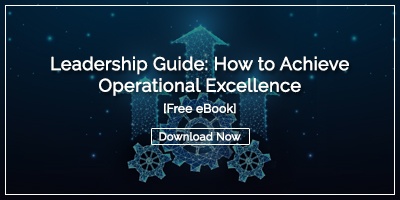 Operational excellence is a management philosophy that focuses on continuously improving an organization's processes, systems, and workflows to optimize performance and deliver value to customers. Operational excellence happens when an organization consistently and reliably outperforms the competition through constant improvement and a dedication to customer value. When two companies have the same strategy, the operationally excellent company will have higher revenues, lower costs, and less risk. This type of execution is only possible with outstanding leadership and a culture that supports problem-solving and transparency.
Operational excellence is a management philosophy that focuses on continuously improving an organization's processes, systems, and workflows to optimize performance and deliver value to customers. Operational excellence happens when an organization consistently and reliably outperforms the competition through constant improvement and a dedication to customer value. When two companies have the same strategy, the operationally excellent company will have higher revenues, lower costs, and less risk. This type of execution is only possible with outstanding leadership and a culture that supports problem-solving and transparency.
This article will outline the essential leadership behaviors for building and sustaining an operational excellence culture.
Understanding Operational Excellence Culture
Operational excellence culture refers to an organizational ethos emphasizing continuous improvement, efficiency, and achieving optimal performance in all business areas. Several vital elements characterize this culture of operational excellence:
-
Continuous Improvement: A commitment to constantly improving processes, products, and services. This often involves methodologies like Lean management, Six Sigma, and Total Quality Management (TQM).
-
Customer Focus: Prioritizing the needs and expectations of customers. This means delivering high-quality products and services that meet or exceed customer expectations.
-
Employee Empowerment: Encouraging employees at all levels to take ownership of their work and contribute ideas for improvement. This involves training, support, and recognizing contributions.
-
Leadership Commitment: Leaders actively support and participate in the pursuit of operational excellence. They provide vision and resources and remove obstacles to enable continuous improvement.
-
Data-Driven Decision Making: Utilizing data and metrics to guide decisions, track performance, and identify areas for improvement. This includes establishing key performance indicators (KPIs) and regularly reviewing them.
-
Standardization and Best Practices: Implementing standardized processes and practices across the organization to ensure consistency and efficiency. This involves documenting procedures and ensuring they are followed.
-
Waste Reduction: Identifying and eliminating waste in all forms, including time, materials, and labor. This is often achieved through Lean principles and practices.
-
Collaboration and Communication: Fostering a collaborative environment where information and ideas flow freely across all levels of the organization. This includes open communication channels and teamwork.
-
Innovation and Agility: Encourage a company culture that supports innovation and the ability to adapt quickly to market or industry changes.
The benefits of operational excellence are significant and wide-ranging. They include:
-
Increased efficiency and productivity: Operational excellence helps to minimize waste, reduce errors, and improve processes, leading to greater efficiency and productivity. This results in cost savings and increased profitability.
-
Improved customer satisfaction: Operational excellence focuses on delivering value to customers, which leads to improved customer satisfaction and loyalty. Organizations develop a competitive advantage by continuously improving processes and offering high-quality products or services.
-
Better decision-making: Achieving operational excellence requires a data-driven approach, meaning decisions are based on accurate and timely information. This leads to better decision-making and more effective strategies for the organization.
-
Increased employee engagement: Operational excellence initiatives require a collaborative approach, which increases employee engagement and morale. Organizations create a culture of constant learning and development by involving employees in the continuous improvement process and giving them the tools and resources they need to succeed.
-
Agility and adaptability: Operational excellence requires organizations to be agile and adaptable in response to changing market conditions and customer needs. By continuously improving processes and systems, organizations are more responsive to changes and better positioned to take advantage of new opportunities.
-
Reduced risk: Operational excellence means identifying and mitigating risks, reducing the likelihood of costly errors and incidents. By continuously monitoring and improving processes, organizations eliminate disruptions to their operations and ensure they operate safely and efficiently.
Key Leadership Behaviors for Operational Excellence
Three core principles guide the actions of leaders who achieve operational excellence:
Visionary Leadership
A clear and compelling vision is crucial for organizations because it serves as a guiding beacon, aligning everyone toward a common purpose and goal. A clear vision helps align the efforts of individuals and teams within an organization. When everyone understands the overarching goal and direction, they can work cohesively towards achieving it. A compelling vision inspires and motivates employees. It gives them a sense of purpose and meaning in their work, which can lead to higher engagement and commitment.
A clear vision can provide stability and direction in times of uncertainty or change. It helps organizations navigate challenges and setbacks with purpose and determination.
Visionary leaders play a crucial role in articulating and championing a clear vision. Visionary leaders empower their teams by delegating authority and trusting them to make decisions aligned with the vision. This autonomy fosters creativity, innovation, and ownership among employees.
Effective Communication
Leaders who promote operational excellence must communicate clearly and consistently with their teams about the organization's goals, expectations, and standards. Excellence is only achieved with a strategic alignment of goals from the board room to the front line. Everyone must have clarity about why the organization exists, its strategic aims, and the milestones on the path to success. Goals must cascade through the organization so everyone can make decisions and suggest innovations aligning with the objectives.
Share Information: Keep your team informed about important updates, decisions, and organizational changes. Transparency builds credibility and reduces uncertainty.
Listen Actively: Create opportunities for team members to voice their opinions, concerns, and ideas. Actively listen to their feedback and demonstrate that their input is valued.
Be Honest and Authentic: Avoid withholding information or misleading your team. Be truthful in your communications, even when delivering difficult messages.
Empowerment and Trust
Many leaders don't talk about respect. Still, if you look at how leaders of the most successful organizations approach their work, you will find signs of respect throughout the operation. For example, high-quality products show respect for customers, on-time payments show respect for suppliers, and professional development opportunities show respect for employees. While C-level leaders aren't necessarily involved in the daily execution of these activities, they cultivate a culture where such respect is the norm.
Respect and empowerment are fundamental when it comes to employees. When employees are trusted enough to engage in problem-solving related to their operations, they become more personally invested in the outcome of every task and more likely to produce the desired result.
Delegate Effectively: Delegate tasks and responsibilities based on team members' strengths and development goals. Empower them to make decisions within their scope of authority.
Provide Resources and Development Opportunities: Support your team with the tools, training, and resources they need to succeed. Invest in their professional growth and career development.
Recognize and Celebrate Achievements: Acknowledge individual and team accomplishments. Celebrate milestones and successes to foster a positive culture and supportive work environment.
Encourage Collaboration: Promote teamwork and collaboration among team members. Create opportunities for cross-functional projects and encourage knowledge sharing.
Show Respect and Empathy: Treat team members with respect and empathy. Understand their perspectives, experiences, and challenges.
Build Personal Connections: Take time to get to know your team members personally. Show genuine interest in their well-being and aspirations.
Sustaining Operational Excellence
Leaders must actively participate in process improvement and other activities that lead to sustainable improvement and operational excellence over the long run.
Continuous Improvement Mindset
Leaders of operationally excellent organizations refuse to accept band-aid solutions. Instead, they search for the root causes of problems and implement effective countermeasures. Next, they recognize that unnecessary complexity leads to waste and defects and seek simple solutions where possible. Finally, they understand that not every change has to be revolutionary or disruptive. Small changes, implemented consistently, move each operation closer to perfection through cultural transformation.
Here are some examples of operational excellence methodologies that companies often implement:
Kaizen: Kaizen is a Japanese term meaning "change for the better" or "continuous improvement." It involves small, incremental improvements made by employees daily.
Lean Manufacturing: Lean principles focus on minimizing waste and maximizing value.
Six Sigma: Six Sigma is a data-driven methodology that improves quality by reducing defects and process variation.
Total Quality Management (TQM): TQM involves all employees in continuous improvement efforts to achieve customer satisfaction.
These examples illustrate various continuous improvement practices and methodologies that organizations can adopt to continuously implement strategies to enhance efficiency, quality, and customer satisfaction. Each practice can be tailored to fit specific industry needs and operational goals, fostering a culture of innovation and excellence over time.
Measuring and Monitoring Performance
Leaders in most organizations have experience and often "know" what's the right thing to do. Operationally excellent leaders are willing to hold their ideas up to the same rigor that scientists apply to test a theory. Does the data support the underlying assumptions? Can an idea be tested in a controlled way to validate its accuracy? Once implemented, how can the change be measured over the long run? Applying this type of analysis is how leaders can learn and adjust.
Operational excellence programs require a data-driven approach, meaning decisions are based on accurate and timely information. This leads to better decision-making and more effective organizational strategies.
Measuring and monitoring operational excellence involves assessing various aspects of organizational performance to ensure that processes are efficient, effective, and aligned with strategic goals. Here are several methods and metrics commonly used for measuring and monitoring operational excellence:
Key Performance Indicators (KPIs):
-
Cycle Time: Measure the time to complete a process or deliver a product/service.
-
Quality Metrics: Track defect rates, errors, or customer complaints about product or service quality.
-
Cost Metrics: Monitor costs associated with production, operations, and maintenance.
-
Productivity Metrics: Measure output per unit of input (e.g., revenue per employee, units produced per hour).
-
Customer Satisfaction: Gather feedback through surveys, Net Promoter Score (NPS), or customer complaints.
Lean Metrics:
-
Value-Added Ratio: Calculate the percentage of time spent on activities that add value to the customer.
-
Lead Time: Measure the time taken from customer order to delivery.
-
Inventory Turns: Track how often inventory is sold and replaced within a specific period
Employee Productivity and Training Metrics:
-
Training Effectiveness: Measure the impact of training programs on employee skills, performance, and adherence to operational standards and process excellence.
-
Employee Turnover Rate: Monitor turnover rates, as high turnover can indicate operational processes or workplace culture issues.
Risk Management and Compliance Metrics:
-
Risk Assessment: Evaluate risks associated with operational processes and monitor controls to mitigate risks effectively.
-
Compliance Audits: Track compliance with regulatory requirements and internal policies to ensure operational excellence and avoid penalties.
Conclusion
Driving operational excellence is not just a goal but a journey that requires steadfast commitment and proactive leadership. Your role as a senior leader is pivotal in shaping the culture and practices that will propel your organization toward excellence. By adopting these behaviors and leading with a focus on operational excellence, you will inspire confidence, foster innovation, and drive sustainable growth within your organization. Together with your team, you can create a culture where excellence is not just a goal but a fundamental part of how you operate every day.

![[Watch Now] The Why, How, and What of Continuous Improvement](https://no-cache.hubspot.com/cta/default/326641/060c8cc9-44ad-4fd1-ad7b-7b4ab71c7632.png)


Add a Comment